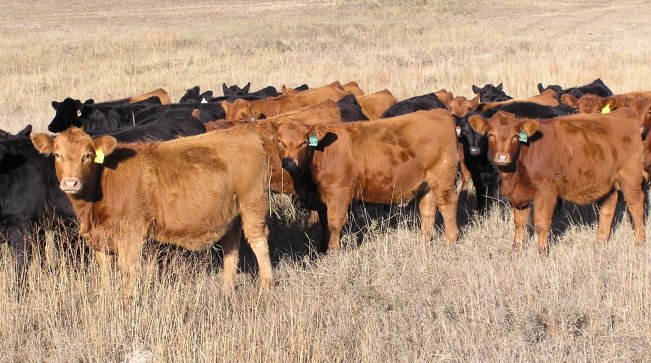
By Rick Funston, UNL Beef Reproductive Physiology Specialist and Aaron Berger, UNL Extension Educator
Replacement heifer development and cow depreciation is the largest expense to most cow-calf operations after feed for mature cows. Thus, producers should strive for systems that optimize replacement heifer development costs, timely pregnancies, and cow herd longevity. In the past several decades, post-weaning development of replacement heifers has focused on feeding heifers to reach a target body weight of 60 to 65% of mature weight at breeding to achieve acceptable pregnancy rates (85 to 95%) in a 45 to 70 day breeding season. This development system was based on historical research indicating heifers bred at approximately 14 months of age should reach this target weight for acceptable pregnancy rates to be achieved.
In an effort to reduce costs, recent research has focused on comparing traditional, more intensive replacement heifer development systems to systems utilizing more inexpensive feed resources to develop heifers to lighter target body weights at breeding (i.e., 50 to 57% of mature weight compared with 60 to 65% of mature weight). Research has demonstrated replacement heifers developed to lower target weights, but are on a positive plane of nutrition before the breeding season through calving can have acceptable pregnancy rates and longevity. These lower-input systems allow producers to develop replacement heifers at lower costs without sacrificing reproductive performance.
Why have recommendations for heifer target body weight at breeding changed?
Genetic Selection
Much of the research recommending heifers be at a target weight of 60 to 65% of mature weight by breeding was conducted from the late 1960s through the 1980s. Since then, the genetic makeup of the U.S. cowherd has changed significantly. Age of puberty does not seem to be limiting heifer development programs as it did in the past. Heifers are reaching puberty at younger ages and at a lower percentage of their mature weight than has occurred historically. These genetic trends have been realized by widespread management changes and the use of Expected Progeny Differences (EPDs) in the selection for a variety of traits, including scrotal circumference and yearling weight.
Greater Understanding of Heifer Development Physiology
Timing of body weight gain: Use of timing when body weight gain occurs in replacement heifer development can be used to reduce development costs. Heifers developed to 50 to 57% of mature weight at breeding can still achieve acceptable pregnancy rates (80 to 95% during a 45 to 60 day breeding season) if the period of slower weight gain is followed by a positive energy balance prior to and through the breeding season. Heifers developed on crop residue or native range at low rates of gain have demonstrated compensatory gain in the spring when placed on higher quality forage. When this compensatory/higher rate of gain coincides with breeding, either A.I. or natural service, it appears to benefit conception and maintenance of pregnancy.
Learning to be a Cow
Replacement heifers developed on forages (often low-quality) they will utilize as cows are often better adapted to their environment than heifers in intensive development systems. It is hypothesized grazing is a learned behavior, suggesting heifers developed on grazed forages acquire more experience consuming forage, allowing them to better utilize these same feed resources as cows. Intensively developed heifers appear to undergo a learning and adaptation phase when introduced to forages, which can coincide with a time when they are already nutritionally challenged as growing yearling heifers being bred for their first calf.
Supplementation Strategies for Summer Breeding of Heifers
Current research validates the importance of nutrition prior to and through the breeding season to achieve acceptable pregnancy rates for heifers developed in a low-input system. Many cow-calf producers have moved to a later spring calving period to decrease labor, increase flexibility in marketing calves, and decrease harvested feed costs. This shift to later spring calving has resulted in heifers being bred in mid to late summer on pasture and rangeland where forage quality is often decreasing. These heifers, adequate in size and age for breeding, often have decreased pregnancy rates. A recent study demonstrated supplementing heifers during a late summer breeding season with a protein supplement (1 lb/hd/day of a 30% crude protein cube containing Rumensin®) on native range resulted in 20 to 25% greater pregnancy rates than heifers not receiving supplement. When breeding occurs during decreasing forage quality, protein supplementation prior to and during the breeding season may be important to the success of the heifer development system.
Summary
Development systems targeting 12 to 14 month old heifers to be at 50 to 57% of mature weight at the time of breeding can result in acceptable pregnancy rates. These systems must employ adequate nutrition prior to and through the breeding season as these heifers need to experience compensatory gain from breeding to calving to ensure adequate size and body condition to calve successfully. Development systems utilizing lower quality forages allow heifers to be developed at lower costs than intensive development systems. When changing to a lower-input development system, it is recommended to initially retain more replacement heifers than needed to determine how herd genetics will respond to a reduced nutritional environment during development.
For more UNL Beef information go to http://beef.unl.edu